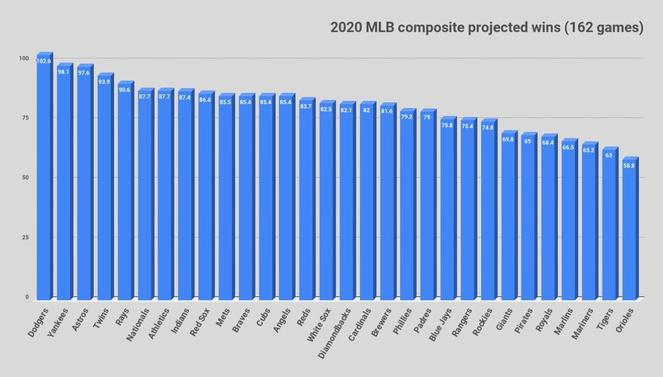We don't yet know the finalized specifics of what the 2020 MLB season will look like, assuming it comes to pass. However, we do know that a larger playoff field is highly likely.
In the expanded wild card era, MLB has handed out 10 postseason berths per season -- one to each of the six division winners plus two wild card bids per league. For 2020 (and probably beyond), MLB is probably going to grow the field to seven playoff teams per league. Such a revised postseason structure was already under consideration even before the COVID-19 shutdown, so don't be surprised if this one sticks beyond the 2020 season. Reportedly, here's how it would work:
- Seven teams from each league make postseason (14 total);
- The team with the best record in each league gets a wild card round bye;
- The two other division winners and top wild card team host all games of three-game series in the wild card round;
- Those two remaining division winners get to pick their wild card round opponents (during a live broadcast) from the three other wild card teams. The top wild card team plays the unpicked team;
- Three series winners and the team with a bye advance to divisional round.
Right now, 10 of 30 teams make the MLB playoffs, which means one-third of the league participates in the postseason. Under the expanded format, 46.7 percent of the league passes muster. Obviously, that's a significant lowering of the playoff bar, and as such a number of teams that didn't profile as contenders under the old system will now have legitimate designs on postseason baseball.
Speaking of which, let's have a look at which teams figure to go from likely also-rans under the old 10-team format to potential contenders under this 2020 structure. To get a better idea of who these teams might be, let's turn to some 2020 projections.
Below you'll see a chart that sorts teams by their projected 2020 win totals. In order to get a broader picture of how teams forecast in 2020, we've averaged the win totals from three projection systems -- FanGraphs, PECOTA at Baseball Prospectus, and our very own SportsLine Projection Model (@SportsLine on Twitter). These projections are scaled to the usual 162-game regular season, and we're going to get perhaps half that many regular season games in 2020. The ordering and what it says about teams' hopes for contention in 2020, however, still applies. To the digits:

As you can see, the results span from the 103-win Dodgers (rounded off) to the 103-loss Orioles. Guided by these composite win projections, let's make some assumptions about the 2020 playoff field. While nothing is of course guaranteed and baseball is in some ways constructed to defy assumptions, let's assume that the Dodgers, Yankees, Astros and Twins are playoff locks (to the extent that a team can be a preseason lock). Now let's roll out that projected 2020 playoff field, based on the numbers above, and see what else jumps out.
- Six division champs: Dodgers (102.6 wins), Yankees (98.1 wins), Astros (97.6 wins), Twins (93.9 wins), Nationals (87.7 wins), Cubs (85.4 wins).
- Four AL wild card teams: Rays (90.6 wins), Athletics (87.7 wins), Indians (87.4 wins), Red Sox (86.4 wins).
- Four NL wild card teams: Mets (85.5 wins), Braves (85.4 wins), Reds (83.7 wins), Diamondbacks (82.1 wins).
As you can see, the bar for the NL is significantly lower than in the AL. In the junior circuit, the post-Mookie Betts/David Price Red Sox are the weakest projected playoff team with 86.4 wins -- i.e., more wins than the projected NL Central champ. In the NL, the barely above .500 Diamondbacks claim the final berth.
Under the old 10-team arrangement, the Indians, Red Sox, Reds and Diamondbacks would've been left out -- again, based on these averaged projected win totals. In essence, the cutoff for a playoff berth in the AL would've been more than a win higher in the AL and more than three wins higher in the NL under the 10-berth model. That's significant on both fronts.
So under the 14-team postseason setup, who would likely be looped into relevance who wasn't before? While it's somewhat arbitrary, let's say teams within five games of the projected win total of the team in final playoff position can be declared likely contenders.
Under the 10-team model, just the Angels in the AL would be added to the pool of contenders by that five-game definition. With the numbers of berths expanded to seven in each league, the White Sox (82.5 projected wins) now fall within five games of the final playoff spot. That's especially good news for the South Siders considering they invested heavily in veteran talent this offseason. New to the fold are Yasmani Grandal, Dallas Keuchel, Edwin Encarnacion, Nomar Mazara and Gio Gonzalez, and they're paired with a deeply impressive young core. Contention is the goal in 2020, and a larger playoff field makes it much more likely, even in the top-heavy AL. So as probable AL contenders in 2020 go you've got the seven teams of the projected AL playoff field above plus the Angels and now White Sox. So that's nine of 15 teams with realistic playoff possibilities.
Over in the NL, it's an even more compelling situation. With five NL playoff bids under the old system, the Cardinals and Brewers -- note that tightly compressed four-team scrum in the NL Central -- would be within five games of the final spot (along with the Reds and Diamondbacks). Expanding it to seven teams drops the bar to the Diamondbacks' 82.1 wins, as you see above. That, in turn, keeps the Cardinals and Brewers in the mix while also looping in the Phillies and Padres. Given that it might be "playoffs or bust" for hot-seated GM A.J. Preller in San Diego, that's notable. Stated another, simpler way, the lone NL teams not within five games of playoff position in the expanded model are the Rockies, Giants, Pirates and Marlins (and it's easy to squint and see the Rockies' being relevant). So under the new playoff format, that's 11 NL teams out of 15 with realistic aims on the playoffs. That should make for a wild season and some quality color television.
The true winners of the new playoff format will be the four teams who claim those freshly minted wild card berths -- the ones who would've been left out in years prior. As we wait for the games to begin, though, the winners are the White Sox, Phillies, and Padres, who would be facing much longer odds under 2019 rules. Also bear in mind that the much smaller sample size of regular season games in 2020 means the season will be more prone to unexpected outcomes. To cite one very recent example, the champion Nationals last season were exactly .500 after 82 games, which may be the length of the 2020 season. Pair that small(er) sample size dynamic with the swelled playoff field, and we could have some highly surprising outcomes in 2020.
![[object Object] Logo](https://sportshub.cbsistatic.com/i/2020/04/22/e9ceb731-8b3f-4c60-98fe-090ab66a2997/screen-shot-2020-04-22-at-11-04-56-am.png)


















